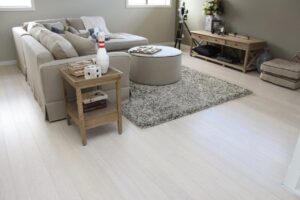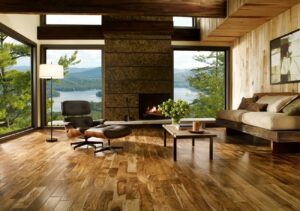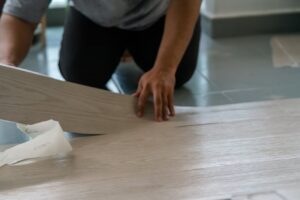Vinyl Plank Flooring Reviews – When you are thinking about remodeling or renovating the house, choosing vinyl plank flooring may cross your mind. You may think about choosing the hardwood, but every homeowner knows that it is going to cost you a fortune.
A carpet may seem like a good alternative, but not so much for those with allergies. You certainly want something that isn’t only beautiful and visually appealing, but also durable and affordable.
Well, vinyl flooring should be able to give all those benefits and perks. It’s time to dig deeper to this type of flooring.

Understanding Vinyl Flooring
Vinyl plank flooring is the type of floor designed to look like hardwood based own reviews. And it usually comes in strips. Vinyl flooring is designed to look every type of wood, not limited exclusively to hardwood.
Such a flooring mostly comes in hardwood design because it is the most popular pick and most homeowners like the fact that it matches the rest of their home decor just nicely and perfectly.
In short, when you want to improve the look of your house without having to spend a fortune, this flooring type would be the best pick. You can also pick such a design without having to deal with the high cost or the difficult installation.
Pros and Cons
Choosing vinyl plank flooring can be the wisest (and almost the most economical) choice that you make based on reviews. But to make yourself sure about the decision, you need to consider the good and bad of picking such a flooring type.
The positive things about vinyl flooring are:
- It offers a great combination of solid firmness and soft plush effect all in one. You see, many of the planks are supported by a felt product. When you install the floor, it somewhat feels soft. The floor looks solid and it has its own solid strength. However, when you stand on the floor for a long time, it is more comfortable definitely more comfortable than standing on real wooden flooring.
- If you are clumsy and you drop things quite often, you should install vinyl. Objects like mugs and glasses aren’t easily broken when they drop on the floor.
- This flooring is great for kitchens and bathrooms because of its water resistant nature. Some of them are even waterproof. Totally.
- If you want to achieve a cost-effective and fast installation process (not to mention also easy), vinyl is a good option. You can install the planks on the top of the subfloor directly. But the subfloor should be in a good condition. You only need to check the subfloor after removing the old flooring. If everything is still in good condition, then install the vinyl right away.
- Caring for vinyl isn’t complicated or difficult at all. Vinyl planks are long-lasting as long as you can clean it in a routine manner (such as sweeping and mopping). It will look great with very minimal maintenance. In fact, the floor can last for 20 years with proper care. Not so bad to save yourself some money over those years, eh?
- In the event you are planning on increasing your home’s value and luxury, you have te options to install a heating system (the in-floor) type beneath the vinyl floor.
However, despite all the great reviews things about vinyl plank flooring, the floor isn’t 100% perfect.
There are several downsides about the floor:
- Vinyl has this tendency to warp to the particles (any of them) left beneath them. For example, if you leave a bit of dust, even just a tiny part of it, underneath the floor, it will turn into a bump eventually. That’s why you should be extra careful when installing the floor. You need to clean it thoroughly as well as being careful when installing the planks, so there won’t be any particles left under the planks.
- Vinyl is long lasting, but it doesn’t mean that it is super resistant and strong. When you move heavy furniture or drop a glass, you make difficult-to-remove gouges and scuffs. How to avoid it? Don’t drop anything on it. If you want to move the furniture, you need to lift the piece up or use a felt to cover the feet.
- Vinyl isn’t actually adding the property value. If you are thinking about increasing your house’s resale value, then vinyl won’t be the wisest option that you can make.
Hopefully, these lists of the pros and cons of vinyl flooring can help you decide which flooring would be best for your needs.
Read Also: Grey Vinyl Flooring to Transform Your House Amazingly
Thickness
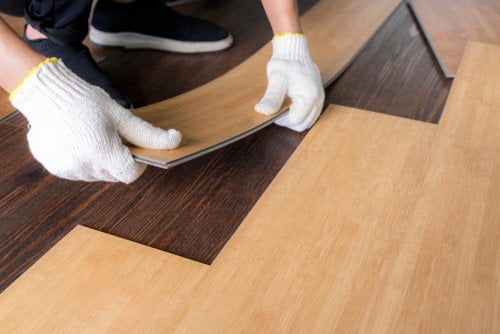
Considering the thickness of the floor shouldn’t be taken for granted. The thickness depends on the backing, the core, and protective wear layer and you need to have all those three to calculate the right depth.
You should be able to find the information about the thickness of the wear layer on the products. But be careful they often write the opposed numbers to the actual thickness. The actual thickness is usually expressed in mm.
The lower quality plank is generally set around 4mm while the higher quality ones are 8mm or even thicker.
The wear layer refers to the layers between the urethane finish and the printed design. This is the layer that will decide how long your floor will last.
If this layer breaks down, the printed design will fade because of the damage. High quality vinyl planks flooring have protective top coat on the layer.
The top coat contains special additives, such as ceramic or others, so the hardness level can increase. The wear layer level is generally expressed in mil completely different from millimeter.
Thicker layer would be stronger, more resistant to dent and scratches. High quality flooring can have between 12mil and 28 mil of thickness but the higher it is, the more expensive it will be.
The minimum thickness should be 12 mil don’t go less than that.
The high-quality vinyl planks have a solid core known as WPC, a type of wooden plastic composite.
Despite the name, it doesn’t contain any wood or whatsoever. It contains wood flour that is fused together with calcium carbonates and thermoplastic.
This plank is generally safe for families because it is free from phthalates. Planks with rigid and solid center will have better stability and improved durability. The core is generally water resistant.
The bottom side (or the backing) includes corking and other soundproofing elements. These are the layers providing underfoot cushioning feature.
The thicker the bottom, the more comfortable it will be, especially if you have to stand for a long time.
Some of these planks come with attached underlayment designed to deliver better sound reduction and heat retention. You want to find planks with this feature for your second floor.
The newest technology would use recyclable materials. They are friendly for environment but they aren’t as long lasting as the regular ones.
Durability
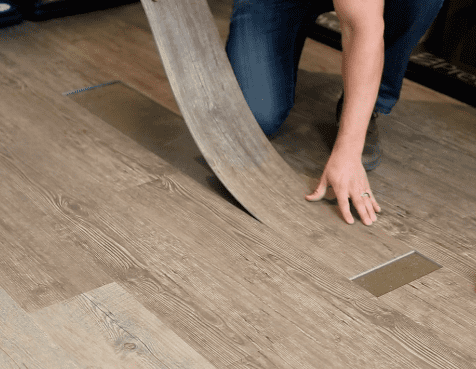
When compared to hardwood floor, vinyl planks are resistant to dings, scratches, and other flaws. They are often expensive to repair.
The planks surprisingly are pretty tough against pressure. It isn’t prone to scratching from animals or active kids. It is safe to say that vinyl floor is tough and durable even with the heavy traffic.
As it was mentioned before, the floor can last for 20 years with proper care and maintenance.
Vinyl Plank Flooring Feature
Different types of flooring will lead to different kinds of features. Each of the floor has its own signature style.
So, when you are about to choose a type, make sure that it has all the features that you want.
Waterproof Vinyl Plank Flooring
As the name suggests, the floor is waterproof. It usually has four layers of construction with waterproof core. And this one is basically versatile feel free to install it anywhere you see it fits.
Because of the waterproof nature, you can install it in kitchens and bathrooms. However, the floor is also perfect when you want to install it in the living rooms, basements, and other rooms in your house.
Lifeproof Vinyl Plank Flooring
This floor was originally known as Allure before the name changed. Not only it is beautiful, but it is also affordable. The planks are coming in different width as well as various beautiful designs.
They have deep embossed so they will look like natural wood grains (think of pine, hickory, and oak). The wear layer is 6 mil and it is resistant to skids, marks, and scratches.
If you have pets or kids, or you have super active life at home, look for the ones with 12 mil of wear layer. The floor is antimicrobial, which makes it perfect for people with allergies or kids. It is also waterproof with solid PVC core.
So, if you are looking for a floor with beautiful design and solid construction (without hurting the wallet), this one would be the best pick.
Luxury Vinyl Plank Flooring
In this type of flooring, the floor is durable and thick with multiple layers. It has a tough and solid wear layer with realistic image. The construction is rigid and the floor itself is super durable.
They’re not the type of peel and stick variant, but we even have the peel and stick type with luxury branding! The planks are perfect for high traffic, so they are just ideal for commercial buildings.
For homes, they are perfect for pets and also kids. Thanks to the tough construction and high-quality materials, they can last for a long time.
How to Install Vinyl Plank Flooring Quick and Simple
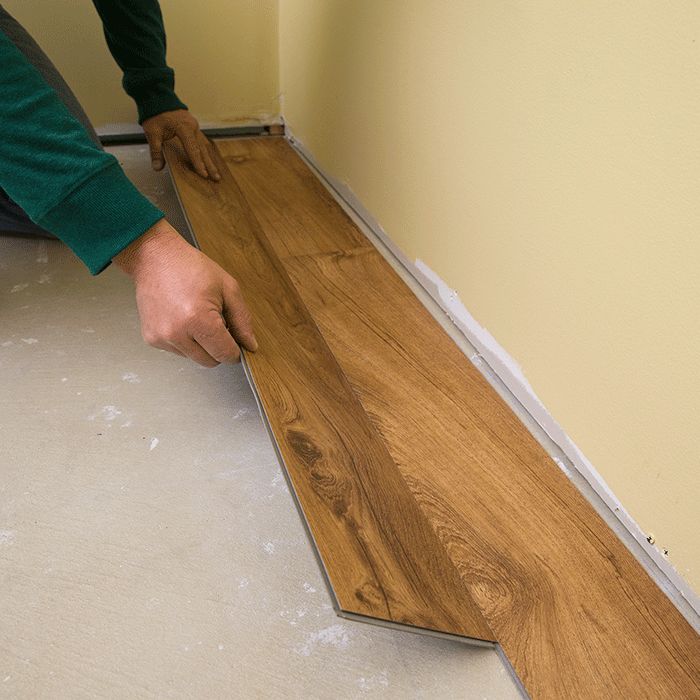
You are probably thinking about installing your own vinyl plank flooring mostly because of the easy claim.
Well, you can do it on your own but make sure that you dedicate enough time to do it. And you shouldn’t rush things or you will turn everything into a chaotic mess.
So, how much is the cost to install vinyl plank flooring?
Well, basically, it costs you $250 to $400, depending on the type of floor you choose and the quality. For a place with 120 square feet, it takes around 3 to 4 hours. You need fine-tooth saw, tape measure, utility knife, and straight edge to do it.
Here are the general steps to do it:
- Choose the most visible wall. Then you can move outward. Lay the first row parallel to this wall and move across the room. In bigger rooms, you lay the (first) row down to the center. Afterwards, move outward on both sides moving to the walls.
- Don’t forget to remove the trim, which means that you need to remove any casing making contact with the floor, such as door trim, quarter round, and baseboards. In most cases, removing the door will be a great help.
- Now, cut the vinyl flooring. And how to cut vinyl plank flooring? As you will have to run the row of planks down the wall’s length, you can cut them with your utility knife. Run the knife across the plank’s face lightly. Do it several times instead of cutting deep grooves. If you are more comfortable with the fine-tooth saw, you can cut the entire board thoroughly.
- You need to think about connecting the planks now because there are different connecting mechanisms. There is side-to-side along with end-to-end mechanism. There is also the fold-and-lock mechanism with a groove and tongue method. You need to lay the first plank flat and then another one should be held on a certain angle. Then, the second one is placed to the receiving groove of the first plank. You should hold the second board flat to the first board (and it should be parallel too). It will help drawing the boards together as well as locking those boards in place firmly.
- After you have laid the planks, you can re-attach the trim again. Although you can always use the hammer and nail, it is advisable to use the electric brad nailer to finish the work. Manual hammer and nail may stress the trim or even worse cracking it. So, it is wiser to buy yourself an electric nailer which is actually inexpensive.
Basically, there are some technical details about installing the floor. You can perform your own research concerning them and learn about the specific details.
How to Clean Vinyl Plank Flooring
Caring and maintaining vinyl plank flooring is pretty simple. You simply sweep it like usual or mop it.
A regular wet mop is okay, but you aren’t supposed to pouring water over the floor. Drenching the floor isn’t recommended because water can seep into the underneath edges and seams breaking the adhesive down.
You don’t need to use harsh or strong cleaner either. Mild cleaners will do. If you don’t have any big mess, a traditional mop (or a dust mop) remains effective to clean the floor. You don’t need waxing either.
Read Also: Dark Vinyl Flooring Ideas to Transform Your Home
Vinyl Plank Flooring Reviews
Don’t forget to perform your research concerning the vinyl plank flooring reviews.
If you read those vinyl plank flooring reviews, you will see that most of them are quite positive. Most homeowners are happy about the floor and how the floor can improve their home.
FAQ About Vinyl Plank Flooring
Which direction to install vinyl plank flooring?
The plank must be installed parallel to the longest wall within the room. Let’s say that you have a room with 5 x 8 feet size, then the planks should be installed first along the 8-foot wall.
This would create the best look. Most people would start on the left side (of the room) and move to the right.
Can you use a Swiffer on vinyl plank flooring?
It isn’t advisable to use Swiffer on this type of flooring. First, the cleaner is pretty strong much perfect for real hardwood. It also has a strong smell too. Second, it somehow takes longer time to dry. And then, it will streak on your entire floor. I won’t recommend Swiffer on regular use.
Can you use a Swiffer on vinyl plank flooring?
It isn’t advisable to use Swiffer on this type of flooring. First, the cleaner is pretty strong much perfect for real hardwood. It also has a strong smell too. Second, it somehow takes longer time to dry. And then, it will streak on your entire floor. I won’t recommend Swiffer on regular use.
Can you use a steam mop on vinyl plank flooring?
No, a steam mop isn’t advised for this type of flooring. The heat can break down the glue and adhesive.
How long does it take to install vinyl plank flooring?
In general, a room with 120 feet of size would take about 3 to 4 hours. But if this is your first time, be ready to spend more time up to 5 or 6 hours.
Is vinyl plank flooring waterproof?
Most of the vinyl flooring types are water resistant. Their ability to deal with water is absolutely perfect as they are 100% waterproof.
Can you put vinyl plank flooring over ceramic tile?
You can install vinyl flooring on seamless, smooth, and tightly sealed surface. If the grout lines are thin and well installed enough, then yes, you can install the plank over the ceramic tile.
What are the disadvantages of vinyl plank flooring?
If you have read the previous section in this article, you will see some of the downsides include warping and scuffs.
Can you put vinyl plank flooring over linoleum?
Yes, provided that the linoleum is still in good shape and condition without any missing tiles
Can you remove scratches from vinyl plank flooring?
Yes, you can but it is going to take you the extra efforts. You need to sand the floor first. Sanding can remove the scratches without even removing the finish. Rub the spot within the same direction of the scratch. If you feel that they are smooth enough, and then wax the floor. Waxing will make the floor shiny again. Make sure to do it in circles and be gentle about it.
Can you install vinyl plank flooring over tile?
Yes, as you can install the plank over ceramic tile, you can install it over tile provided all the requirements are met.
Can you put rugs on vinyl plank flooring?
Rubber rugs on general aren’t the perfect match for the flooring. But there are several rugs that don’t contain rubber they contain from natural ingredients, such as soy oils and also bio-based fillers to prevent damage to the floor. Those are the complete facts about this type of versatile floor. Make sure to do a complete research about vinyl plank flooring and whether it would be perfect for you.



